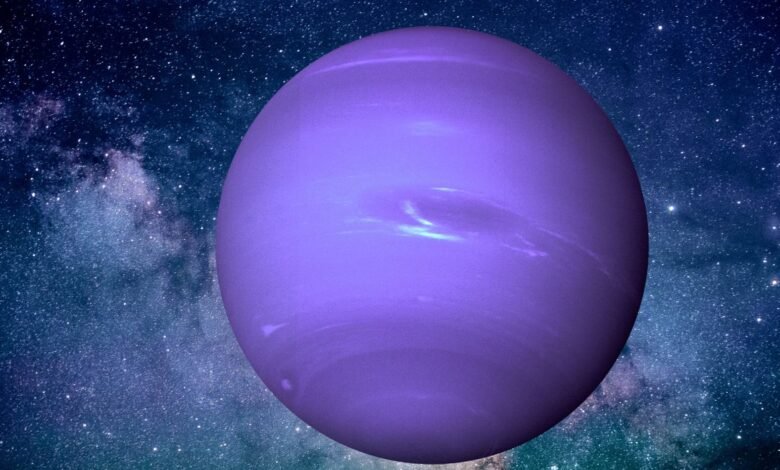Shocking! New Exoplanet Stinks Like Uranus!

Uranus, fittingly, smells like a giant fart. The planet is full of hydrogen sulfide, the gas that gives rotten eggs their distinct smell.
Now, we’ve found the same stench elsewhere in the Milky Way. The James Webb Space Telescope (JWST) identified hydrogen sulfide on the scorching Jupiter-sized exoplanet HD-189733b.
“We had projected hydrogen sulfide as a major chemical, but we hadn’t found it outside of the Solar System. It helps us understand sulfur’s role on other planets,” says Guangwei Fu, an astronomer at Johns Hopkins University.
While HD-189733b is too hot for life, finding hydrogen sulfide there is a step toward discovering this molecule on other planets and learning about planet formation.
Since the early 1990s, we’ve discovered thousands of exoplanets and developed methods to analyze them. One way is to watch a star’s light decrease slightly—a phenomenon known as a transit—when an exoplanet passes in front of it. Due to the planet’s atmosphere, certain molecules can be distinguished by their distinct emission and absorption lines in this light.
Situated roughly 64.5 light-years from Earth, HD-189733b is a “hot Jupiter” identified in 2005. It is a gas giant that revolves around its host star once every 2.2 days in an incredibly tight orbit. The exoplanet reaches scorching temperatures in the thousands of degrees due to its close proximity to its star.
A Strange Planet with Lethal Weather
After discovering HD 189733b in 2005, researchers classified it as a “hot Jupiter”—a planet with scorching temperatures and a chemical makeup similar to Jupiter, the largest planet in our solar system. Astronomers can investigate HD 189733b, the closest hot Jupiter to Earth, as it moves in front of its star. It’s one of the most studied exoplanets.
“As one of the first transiting exoplanets discovered, HD 189733b is a gas giant and a pioneer in exoplanet research,” according to Johns Hopkins University astrophysicist Guangwei Fu. “It is key to understanding exoplanet atmospheres.”
The planet is 10% larger than Jupiter but much hotter because it is 13 times closer to its star than Mercury is to our sun. Fu states that HD 189733b orbits its star in just two Earth days.
Sweltering at 1,700 degrees Fahrenheit (926 degrees Celsius) and experiencing powerful winds that propel glass-like silicate particles sideways at 5,000 miles per hour (8,046 kilometers per hour), the planet endures extreme conditions.
Modern and precise: Using gene editing to change the blueprint of an organism
Unexpected Stench
Astronomers were surprised when they used the Webb telescope to investigate the planet to see what infrared light—which is invisible to the human eye—could reveal about HD 189733b’s atmosphere.
Though proof of hydrogen sulfide has been hard to come by outside of our solar system, the molecule was predicted to exist on gas giant exoplanets and is present on Jupiter.
According to Fu, one of the primary sulfur reservoirs in planetary atmospheres is hydrogen sulfide. “With the Webb telescope’s great accuracy & infrared capabilities, we have found hydrogen sulfide on exoplanets for the first time.” This provides a new spectral window for researching the sulfur chemistry of the atmosphere on exoplanets, helping us understand the makeup and formation of these planets.
The discovery of water, carbon dioxide, and carbon monoxide in the planet’s atmosphere by scientists raises the possibility that these elements are typical of other gas giant planets.
Despite being uninhabitable due to its extreme heat, HD 189733b’s sulfur detection aids in our understanding of planet formation. “Sulfur is essential for building complex molecules,” Fu clarified. As with carbon, nitrogen, oxygen, and phosphate, sulfur research is vital to comprehending the formation and composition of planets.
Ammonia is one of the characteristic smelling molecules already found on other exoplanets. Thanks to Webb’s capabilities, scientists can now more precisely identify particular substances in exoplanet atmospheres than ever before.
Heavy Metals on Planets
There might be a link between metal content and mass. Ice giants like Neptune and Uranus have more metals than the larger Jupiter and Saturn, despite being smaller.
Astronomers believe Neptune and Uranus formed with more ice, rock, and metals instead of just hydrogen and helium.
Webb’s research also showed that HD 189733b’s metal content is similar to Jupiter’s.
“Now we have this new measurement showing that the planet’s metal concentrations are key for studying how a planet’s composition varies with its mass and size,” Fu stated. “After their cores form, the findings support the theory that planets form by accumulating more solid material, which is subsequently enriched with heavy metals.”
To find out if high sulfur levels influence how near planets originate to their stars, researchers will now search for sulfur on additional exoplanets.
“HD 189733b is important, but just one example,” Fu said. “We want to use more data from Webb to understand how planets form and see if our solar system is unique.”
Future Directions in Exoplanet Research
Understanding HD 189733b and its sulfur content is just the beginning. Future observations with instruments like the Webb telescope will delve deeper into exoplanet atmospheres, looking for more clues about their compositions and formation processes.
The discovery of sulfur on HD 189733b opens up new avenues for studying the chemistry of exoplanet atmospheres. By studying these distant worlds, astronomers hope to uncover whether our solar system is unique in its planetary makeup or if similar processes occur elsewhere in the universe.
As technology advances and our observational capabilities improve, we may soon unravel more mysteries about these distant planets, shedding light on the diversity and complexity of planetary systems beyond our own.



